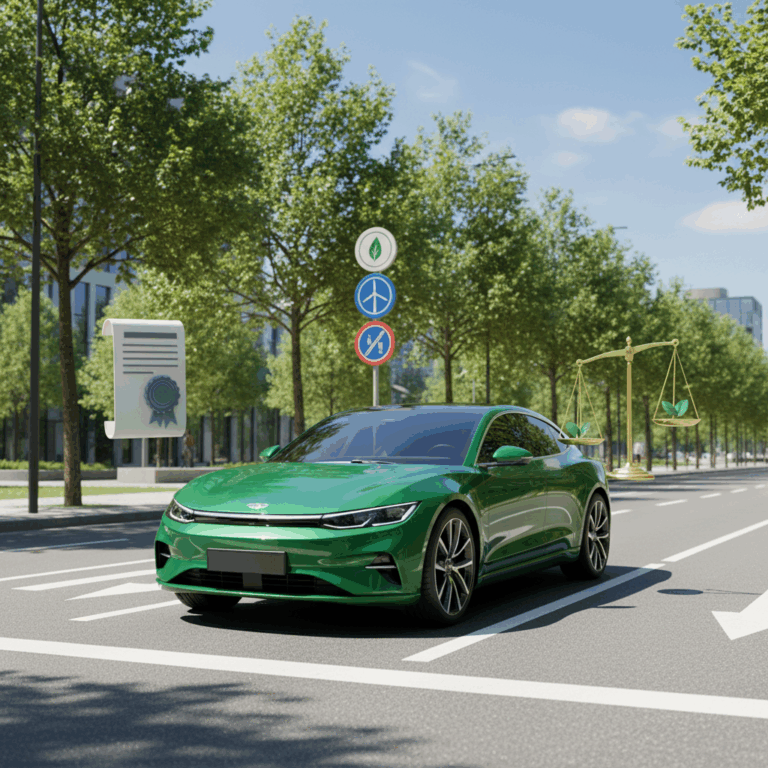Overview of Green Car Legislation
The adoption of green vehicles is driven by laws aimed at reducing greenhouse gas emissions and promoting sustainable transport. These laws influence manufacturers and consumers alike.
In Europe, legislative frameworks focus on limiting emissions and encouraging electric vehicle sales to meet climate goals and improve air quality in urban areas.
Emissions Limits Set by the European Union
The European Union has set strict CO₂ emission limits for car fleets, pushing manufacturers to innovate towards cleaner technologies. This promotes a shift to electric vehicles.
Starting January 1, 2025, vehicles must not exceed 93.6 grams of CO₂ per kilometer, driving demand for zero-emission options and reducing overall pollution from transport.
These limits serve as a benchmark for environmental standards and provide clear incentives for automakers to offer greener options in the market.
National Sustainable Mobility Laws
Countries like Spain have enacted sustainable mobility laws to complement EU rules by encouraging electrification and reducing vehicle emissions nationwide.
Spain’s Sustainable Mobility Law of 2025 implements environmental labels to restrict access for polluting vehicles in cities and mandates rapid charging stations at key service points.
This national approach supports climate targets and urban air quality, while offering financial incentives to promote green vehicle adoption among consumers and businesses.
Specific Laws and Regulations Encouraging Electric Vehicles
Several targeted laws encourage the adoption of electric vehicles (EVs) to meet climate goals and reduce transport emissions. These regulations provide frameworks for incentives and infrastructure development.
By establishing clear standards and incentives, countries aim to accelerate the shift from conventional vehicles to clean alternatives, supporting sustainable mobility and urban air quality improvement.
Spain’s Sustainable Mobility Law 2025
Spain’s Sustainable Mobility Law 2025 fosters electrification by revising environmental labels to prioritize low-emission vehicles and restrict polluting cars in urban areas.
The law mandates installing rapid charging points at major service stations, ensuring better infrastructure support for EV users and increasing accessibility across the country.
Additionally, it includes plans for financial incentives targeting consumers and companies to enhance electric vehicle adoption and contribute to carbon reduction goals.
Portugal’s Incentives for Zero-Emission Freight Vehicles
Portugal promotes sustainable freight transport by offering financial incentives for zero-emission vehicles, including light electric trucks and electric cargo bikes, reducing emissions in last-mile deliveries.
These incentives reflect Portugal’s commitment to decreasing polluting vehicle use in logistics, encouraging businesses to transition to cleaner vehicle options and improve urban air quality.
Such policies support broader EU objectives by targeting specific sectors like freight, enabling faster decarbonization in transportation and fostering innovative green technologies.
European Union CO₂ Emission Thresholds
The European Union enforces strict CO₂ emission thresholds, requiring that new cars emit no more than 93.6 grams of CO₂ per kilometer from January 1, 2025.
This threshold pressures manufacturers to increase electric and low-emission vehicle production and pushes consumers toward cleaner choices by limiting high-polluting models.
These limits are central to the EU’s strategy for meeting climate commitments and accelerating the transition to zero-emission transportation across member states.
Incentive Programs for Green Vehicle Adoption
Governments deploy incentive programs to accelerate the adoption of green vehicles. These initiatives reduce upfront costs and promote cleaner transportation options.
Financial support schemes are crucial to overcome affordability barriers, encouraging consumers and businesses to choose electric and low-emission vehicles.
Spain’s MOVES III Incentive Program
Spain’s MOVES III program offers incentives for purchasing electric vehicles and installing charging infrastructure, aiming to boost sustainable mobility in 2025.
This program includes tax credits and grants that lower the cost of EV ownership, intensifying the transition to low-emission transport nationwide.
MOVES III supports meeting Spain’s decarbonization goals, pairing consumer benefits with infrastructure development to ensure long-term adoption success.
Tax Deductions and Financial Incentives
In addition to direct subsidies, tax deductions play a key role in promoting green vehicles by reducing the financial burden on consumers and companies alike.
These fiscal incentives target electric vehicle purchases, home charging station installations, and retrofitting existing fleets to lower their emissions.
Such measures effectively encourage market uptake by improving affordability and accelerating the shift to sustainable mobility solutions.
Infrastructure and Urban Access Measures
Infrastructure development is essential to support the growing number of electric vehicles and to improve urban air quality. Governments are implementing requirements for charging stations and access restrictions.
Urban access measures focus on limiting the entry of polluting vehicles into city centers. These policies encourage cleaner transportation and foster healthier urban environments for citizens.
Electric Vehicle Charging Infrastructure Requirements
Legislation mandates the installation of fast charging stations at major fuel stations and key points to ensure convenient access for electric vehicle users.
These requirements promote widespread availability of charging options, reducing range anxiety and encouraging consumers to transition to EVs more confidently.
Infrastructure regulations also include standards to integrate charging points into public spaces and residential areas, facilitating everyday use and supporting long-term sustainability goals.
Restrictions on Polluting Vehicles in Urban Areas
Many cities enforce low-emission zones that restrict or ban high-polluting vehicles from entering certain urban areas to reduce air pollution and improve public health.
These access limitations motivate vehicle owners to switch to cleaner alternatives or face penalties, thus accelerating the adoption of green transportation solutions in dense population centers.
By targeting the most polluting vehicles, these measures contribute significantly to lowering urban emissions and enhancing quality of life for all residents.







